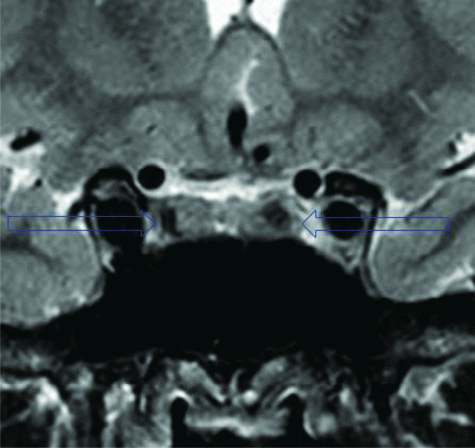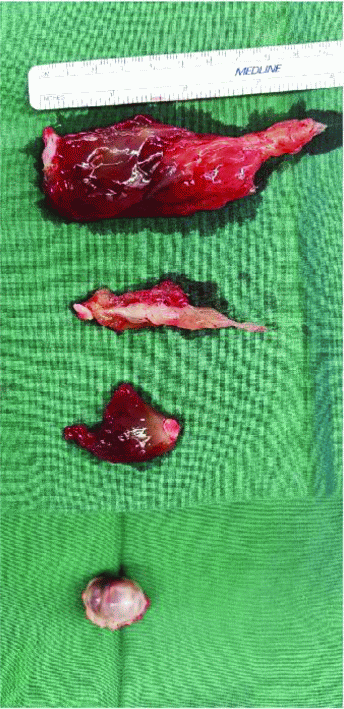BES2020 BES 2020 Carney complex presenting with significant cardiac myxomas and acromegaly, a case-report (1 abstracts)
Carney complex presenting with significant cardiac myxomas and acromegaly, a case-report
Bourgeois Thibault 1 , Van den Bruel Annick 1 , Debonnaire Philippe 2 , Vergauwen Wim 3 & Vandelanotte Sylvie 4
1Department of Endocrinology, AZ Sint-Jan Bruges, Ruddershove 10, 8000 Bruges, Belgium; 2Department of Cardiology, AZ Sint-Jan Bruges, Ruddershove 10, 8000 Bruges, Belgium; 3Department of Cardiac surgery, AZ Sint-Jan Bruges, Ruddershove 10, 8000 Bruges, Belgium; 4Department of ophthalmology, AZ Sint-Jan Bruges, Ruddershove 10, 8000 Bruges, Belgium
Case: An eighteen-year-old male was forwarded to our department by the ophthalmologist because of the resection of an angiomyxoma of the right eyelid. Medical history included multiple surgically excisions of myxomatous tumors from the skin (gluteal, scapular…). Clinical examination showed some lentiginous lesions on his back and more important clear stigmata of acromegaly (tall stature, wide nose, large hands…). Hence our suspicion of a syndromic disorder, in particular the Carney Complex, a quick referral to the cardiologist was ordered. TTE showed three prominent cardiac lesions in both ventricles near the tricuspid and mitral valve. TEE and CT angiography confirmed the lesions, no significant valve insufficiency or stenosis was observed. However due of the high risk for systemic embolization and risk of cardiac outflow tract obstruction and subsequently heart failure, our patient was admitted for semi-urgent cardiac surgery. Hormonal evaluation confirmed the diagnosis of acromegaly with significant elevation of growth hormone levels (GH 30.93 (g/l and IGF-1 1472 ng/ml). Subsequently magnetic resonance imaging (MRI) of the brain displayed two small pituitary adenomas (Figure 1). Lanreotide (120 mg), Somatuline depot injection, every 4 weeks was started prior to the cardiac surgery, in treatment of acromegaly and for prevention of intra/postoperative pituitary apoplexy. The evidence for the timing of cardiac surgery when a macro-adenoma had been present is at least controversial. Some reports recommend to consider trans-sphenoidal resection of the adenoma first or do an ‘off pump’ cardiac surgery given the high prevalence of life-threatening pituitary apoplexy postoperatively (1). Our patient underwent a successful surgical resection of four cardiac myxomas via median sternotomy (Figure 2).

Figure 1. Pituitary MRI (coronal plane) shows 2 (small) pituitary adenomas (respectively 7–7.7 mm and 5 mm).

Figure 2. Successful surgical resection via median sternotomy of four cardiac myxomas (one myxoma in right ventricle and three myxomas in left atrium/ventricle).
Besides a rigorous search for other major criteria was performed. Scrotal echography showed two small lesions congruent with large cell calcifying sertoli cell tumors (LCCSCT). Because of the presence of three major criteria, a search for the identification of a pathogenic variant in the PRKAR1A gene was started. The Carney complex (CNC) is a rare autosomal dominant syndrome which is characterized by multiple myxomatous tumors, including cardiac myxomas, pigmented lesions of the mucosae and skin and numerous endocrine and non-endocrine neoplasms (2). The syndrome is generally caused by inactivating mutations in the PRKARA1 gene which codes for an important regulatory subunit for protein kinase A and subsequently leads to excessive cell proliferation (3). We refer to a recent review, which summarize important criteria for the diagnosis. Genetic counseling is recommended if a patient has two or more diagnostic criteria. If present, it’s recommended for testing other family members as well because there are multiple manifestations of the disease that require (urgent) treatment (4). Genetics showed eventually the presence of c.549+1G>A variant on exon 6 located on the PRKAR1A gene and very likely confirms the diagnosis of Carney complex.
In conclusion, the Carney complex is a rare autosomal inherited syndrome with potential life-threatening manifestations. If the syndrome is suspected, semi-urgent echocardiography has to be performed to detect cardiac myxomas. If present early cardiac surgery is recommended hence the risk of fatal cardiovascular events in this especially young population of patients. However, measurements have to be taken to detect and prevent intra/postoperative pituitary apoplexy given the high prevalence of adenomas.
References: 1. Kim YH, Lee SW, Son DW, Cha SH. Pituitary apoplexy following mitral valvuloplasty. J Korean Neurosurg Soc. 2015;57(4):28991.
2. Stratakis CA, Kirschner LS, Carney JA. Clinical and molecular features of the Carney complex: diagnostic criteria and recommendations for patient evaluation. J Clin Endocrinol Metab. 2001;86(9):40416.
3. Zawadzki KM, Taylor SS. cAMP-dependent protein kinase regulatory subunit type IIbeta: active site mutations define an isoform-specific network for allosteric signaling by cAMP. J Biol Chem. 2004;279(8):702936.
4. Correa R, Salpea P, Stratakis CA. Carney complex: an update. Eur J Endocrinol. 2015;173(4):M8597.

 }
}



